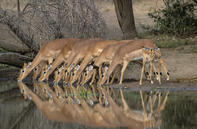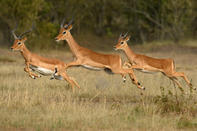Two Dimensional
Impala use a camouflage strategy called counter-shading. They have a darker colour on their backs than on their flanks and the flanks are darker than the pale belly.

This effect reverses the natural 3D effect caused by the sun falling on an object i.e. sun from above illuminates the top of the object most, the sides slightly less and the underparts the least. The result is that to a predator that sees in hues of light and shadow rather than pure colour vision, the impala will appear two dimensional and thus not stand out amongst the landscape as much as if it was 3D.
Rocking Horse Gait

Impala are very athletic antelope able to execute jumps of about 3 meters up and 12 meters far. This suits their wooded environment as they can then go over bushes instead of having to navigate around them. Impala also employ a gait known as ‘the rocking horse’ gait. This is where the impala rocks between its front and hind limbs in a slower canter as it flees.
This gait is believed to indicate health and fitness to predators demonstrating to the pursuer that it isn’t worth its while to try and catch that particular individual. Young impala also bound in this fashion apparently in play. This probably serves a more vital function in the form of toning the muscles required for the athleticism key to their survival.
Unique Glands

The black glands on the ankles of impalas’ back legs are unique to the species. These are called metatarsal glands.
Despite much investigation, the actual function of these glands is still uncertain. They are apparently activated when an impala kicks up its hind legs when running and it is thought that they may play some sort of role in regrouping after a threat has scattered the herd.
By Megan Emmett